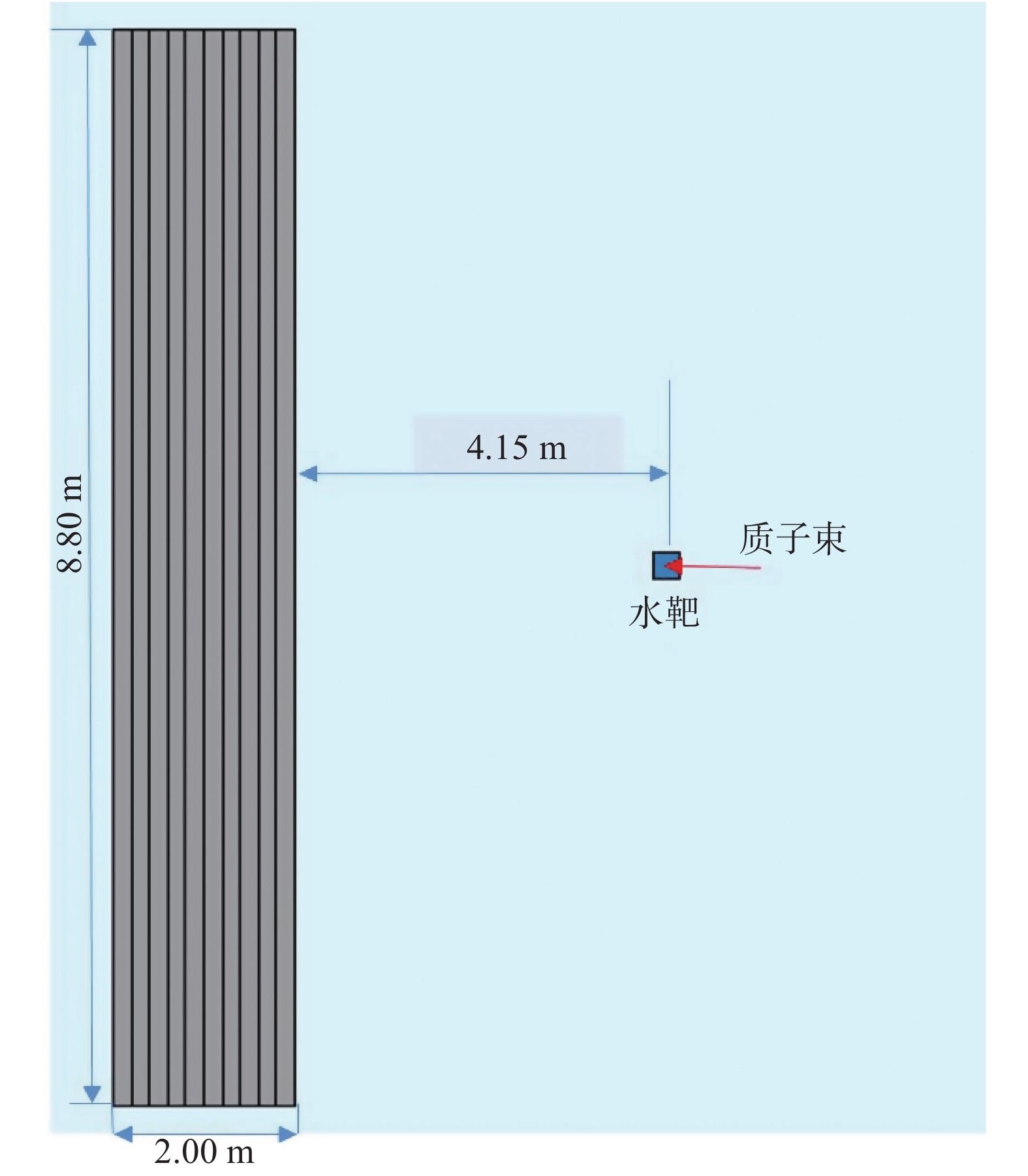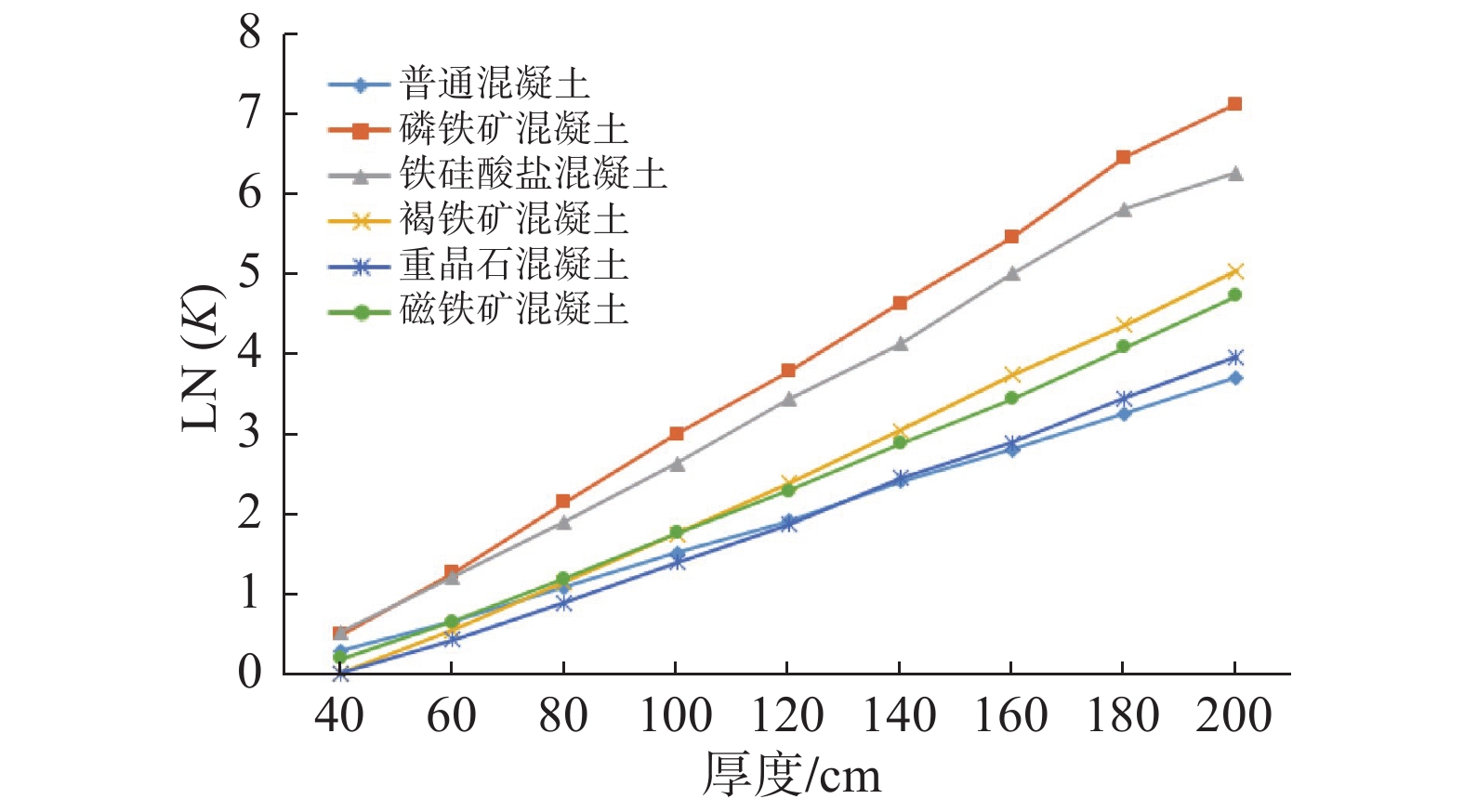加速器产生的质子自1946年提出以来,因其优越的物理和生物学特性,被广泛运用到肿瘤放射治疗[1-3]。质子与物质相互作用,会产生大量的复杂的次级辐射,给质子治疗室的屏蔽设计带来了较大的麻烦[4]。目前质子治疗机房主要采用普通混凝土或者普通混凝土中加一定厚度钢板的方式,采用普通混凝土的墙体较厚,建设过程中施工难度大[5]。目前有研究发现,在混凝土骨料中添加铁、锰等重金属材料,获得的新型混凝土在光子和中子屏蔽性能会有明显提升,这样能减少屏蔽体厚度,节省空间,在质子治疗机房的建设中备受建设者青睐[6-9]。因此,研究添加不同骨料后的混凝土对质子的屏蔽性能,对质子治疗室建设屏蔽材料的选择和设计至关重要。
本研究结合国内某质子治疗机房屏蔽设计方案,利用蒙特卡罗FLUKA程序[10]构建几何模型,引入不同的混凝土材料构成,模拟计算关注点周围剂量当量率水平随屏蔽墙的变化情况,分析不同混凝土对质子的屏蔽性能。
1 材料与方法 1.1 混凝土材料构成本研究中主要关注了普通混凝土、重晶石混凝土、磁铁矿混凝土、褐铁矿混凝土、磷铁矿混凝土和铁硅酸盐混凝土6种混凝土。各混凝土的密度和组成见表1[11]。每一种混凝土的密度和构成元素的质量分数均被引入到了FLUKA材料卡中。
|
|
表 1 不同混凝土密度、元素构成及质量分数 Table 1 Density, element composition, and mass fraction of different types of concrete |
230 MeV质子与物质作用主要以电离和激发过程为主,同时该能量质子也会进入原子核内,与原子核发生(p,n)、(p,pn)、(p,2n)等核内级联反应。以上核反应会产生大量瞬发中子,中子能量由低到高可分为热中子、蒸发中子和级联中子3部分,其中级联中子的能量在20 MeV以上,且占50%以上。中子与物质的相互作用会因中子的能量、物质的组成而不同。热中子与混凝土中元素作用主要是吸收,形成复合核,放出γ射线。慢中子、中能中子和能量小于100 eV快中子与物质相互作用主要是弹性散射,其中与轻元素占优势,能量大于100 eV快中子与混凝土相互作用主要是非弹性散射,其中重元素占优势。高能中子与混凝土元素发生去弹性散射会产生多个中子。混凝土中添加原子序数较大的元素能有效慢化能量较高的中子,同时吸收γ射线[12-13]。
1.2 几何模型本次研究模拟计算模型按照国内某质子治疗机房的实际尺寸,构建了几何模型,见图1。屏蔽墙厚20~200 cm,墙高880 cm,墙宽710 cm。人体模型采用30 cm × 30 cm × 40 cm水模代替,密度为1.0 g/cm3。

|
图 1 计算模型几何结构 Figure 1 Geometry of the calculation model |
本研究采用的模拟计算软件为意大利核物理研究所(INFN)和欧洲核子研究中心(CERN)联合开发的基于蒙特卡罗方法的FLUKA 4.0程序。为了提高计算的误差,模拟计算的历史数为1.00 × 109。质子能量为230 MeV,束流强度为3.0 nA(6.740 8 × 107粒子/s)。束流方向为水平向西,与水靶和墙体垂直。
1.4 模拟输出本次研究主要记录屏蔽体外的束流方向上关注点(距离水靶中心6.45 m)总的周围剂量当量率。将研究的混凝土墙体分层,每20 cm一层,记录不断叠加层厚后束流方向上关注点的周围剂量当量率。构建关注点周围剂量当量率随屏蔽体厚度的变化曲线,分析不同混凝土的减弱系数和半值层。
2 结 果 2.1 周围剂量当量率没有任何屏蔽材料情况,关注点的周围剂量当量为(5 793.85 ± 39.85) μSv/h。不同混凝土屏蔽材料,不同厚度下关注点的周围剂量当量率模拟结果见表2。
|
|
表 2 不同厚度、不同混凝土材料关注点的周围剂量当量率 Table 2 Ambient dose equivalent rates of the focus for different concrete materials with different thicknesses |
利用FLUKA模拟计算结果,计算出衰减倍数(K),对LN(K)随屏蔽材料厚度变化的关系进行线性拟合。理论计算出不同混凝土的线衰减系数μ、半值层HVL。LN(K)随屏蔽材料厚度变化的关系见图2,不同混凝土LN(K)随屏蔽材料厚度变化线性拟合关系、拟合度、线衰减系数见表3。

|
图 2 不同混凝土对质子治疗束衰减性能 Figure 2 Attenuation property for different types of concrete against proton beams |
|
|
表 3 线性拟合关系、拟合度、线衰减系数 Table 3 Linear fitting relationship, fitting degree, and linear attenuation coefficient |
| $ \begin{split}\\K=I/I_{0}\end{split} $ |
| $ I=I_{0}e^{-μd} $ |
式中K为减弱倍数,LN(K)为K的自然对数,I为屏蔽后的关注点的周围剂量当量率,μSv/h,I0为没有任何屏蔽时关注点的周围剂量当量率,μSv/h,μ为线吸收系数cm−1,d为屏蔽厚度cm。
3 讨 论对于能量为230 MeV的质子治疗室主屏蔽,当其主屏蔽混凝土厚度小于40 cm时,主屏蔽体外关注点的周围剂量当量率会随着主屏蔽混凝土厚度的增加而增加。6种不同材料组成的混凝土,其主屏蔽体外关注点的周围剂量当量率的增加幅度不一样,其中褐铁矿混凝土主屏蔽体外关注点周围剂量当量率增加的最多。大于100 MeV质子与物质作用产生的中子能量由低到高可分为热中子、蒸发中子和级联中子3部分,其中级联中子的能量在20 MeV以上,且占50%以上,其中能量大于10 MeV高能中子与混凝土中元素原子核碰撞会发生去弹性散射,产生多个中子[12-13]。不同混凝土因其所含元素种类及含量的不同,导致发生去弹性碰撞的原子核数量、去弹性散射反应截面不尽相同。因此,230 MeV质子治疗室主屏蔽体屏蔽厚度小于40 cm时,关注点处周围剂量当量率会随着屏蔽厚度增加而增加,且不同混凝土增加的幅度不一。
230 MeV质子治疗室主屏蔽体混凝土厚度大于40 cm时,屏蔽体外关注点的周围剂量当量率水平随混凝土厚度变化均呈指数下降趋势,由此可以推断在质子束打靶后产生的能量大于10 MeV的高能中子经过40 cm左右的混凝土后被慢化。
230 MeV质子治疗室主屏蔽体混凝土厚度达到一定厚度后,混凝土对质子束的屏蔽衰减也呈指数衰减。通过拟合后的衰减曲线导出的230 MeV治疗室主屏蔽混凝土的线衰减系数的对比可以看出,添加一定质量的原子序数较大的元素的混凝土其屏蔽效果会明显优于未添加原子序数较大元素的普通混凝土。不同混凝土因其添加的原子序数较大的元素种类和含量的不同,其衰减系数也相差较大,其中铁硅酸盐混凝土的线衰减系数最大。因此在质子治疗室的屏蔽材料的选择上,需要结合其屏蔽性能、混凝土材料的施工难易程度,混凝土材料的成本等诸多因素综合考虑。
| [1] |
Zhang Z, Hou CS, Lian DX, e al. Stuly on the shielding and dose rale distribtions of theruputie proton synchrtrun acrelerator hasedl on Fluka[J]. Radiat Pmut Dhwim, 2017, 178(1): 1. |
| [2] |
刘玉连, 赵徵鑫, 张文艺, 等. 质子放射治疗的现状与展望[J]. 中国医学装备, 2017, 14(7): 139-143. Liu YL, Zhao ZX, Zhang WY, et al. The current situation and prospect of proton radiotherapy[J]. China Med Equip, 2017, 14(7): 139-143. DOI:10.3969/J.ISSN.1672-8270.2017.07.036 |
| [3] |
金潇, 严源, 韩春彩. 高能质子治疗系统辐射环境影响评价关键问题探讨[J]. 中国辐射卫生, 2020, 29(1): 65-68. Jin X, Yan Y, Han CC. Discussion on some key issues in radiation environmental impact assessment of high energy proton therapy system[J]. Chin J Radiol Health, 2020, 29(1): 65-68. DOI:10.13491/j.issn.1004-714X.2020.01.015 |
| [4] |
National Council on Radiation Protection and Measurements. Radiation protection for particle accelerator facilities[R]. Woodmont Avenue: National Council on Radiation Protection and Measurements, 2005.
|
| [5] |
Agosteo S, Magistris M, Mereghetti A, et al. Shielding data for 100-250 MeV proton accelerators: Attenuation of secondary radiation in thick iron and concrete/iron shields[J]. Nucl Instrum Methods Phys Res B, 2008, 266(15): 3406-3416. DOI:10.1016/j.nimb.2008.05.002 |
| [6] |
Kaur U, Sharma JK, Singh PS, et al. Comparative studies of different concretes on the basis of some photon interaction parameters[J]. Appl Radiat Isot, 2012, 70(1): 233-240. DOI:10.1016/j.apradiso.2011.07.011 |
| [7] |
Gong JJ, Zhang L, Jia MC, et al. Study on neutron and photon shielding properties of various concretes using MCNP code[J]. IOP Conf Ser Earth Environ Sci, 2018, 199: 032056. DOI: 10.1088/1755-1315/199/3/032056.
|
| [8] |
Sarıyer D, Küçer R, Küçer N. Neutron shielding properties of concretes containing boron carbide and ferro-boron[J]. Procedia Soc Behav Sci, 2015, 195: 1752-1756. DOI:10.1016/j.sbspro.2015.06.320 |
| [9] |
Akkurt I, Basyigit C, Kilincarslan S, et al. Radiation shielding of concretes containing different aggregates[J]. Cement Concr Composs, 2006, 28(2): 153-157. DOI:10.1016/j.cemconcomp.2005.09.006 |
| [10] |
Ferrari A, Sala PR, Fasso A, et al. FLUKA: a multi-particle transport code[R]. Menlo Park: SLAC National Accelerator Laboratory, 2005: 43-295. DOI: 10.2172/877507.
|
| [11] |
Williams III RG, Gesh CJ, Pagh RT. Compendium of material composition data for radiation transport modeling[R]. Richland: Pacific Northwest National Laboratory, 2006. DOI: 10.2172/1023125.
|
| [12] |
邹剑明, 许志强, 耿继武, 等. 基于蒙特卡罗方法的质子治疗室屏蔽防护探讨[J]. 中国辐射卫生, 2019, 28(4): 443-446. Zou JM, Xu ZQ, Geng JW, et al. Radiation shielding design of proton therapy treatment room based on the Monte Carlo method[J]. Chin J Radiol Health, 2019, 28(4): 443-446. DOI:10.13491/j.issn.1004-714X.2019.04.026 |
| [13] |
孙亮、李世俊. 电离辐射剂量学基础[M]. 北京: 中国原子能出版社, 2014: 30-31. Sun L, Li SJ. Basics of dosimetry of ionizing radiation [M]. Beijing: Atomic Energy Press, 2014: 30-31. |



